
- White House OMB Sent Agencies New Policy Guidance on “Delivering a Digital-First Public Experience”
- DE Talk Podcast Discussed Helping Individuals Who Are Blind Find Their Spot in the Workplace
- Amid Ongoing Court Challenges, US DOL Published 2024 Minimum Wages for Federal Contractors
- U.S. EEOC Tries Again with Proposal to Update Workplace Harassment Guidance
- U.S. EEOC Announced Year-End Litigation Round-Up for Fiscal Year 2023
- In Brief
- New Publications
- Looking Ahead: Upcoming Date Reminders
Friday, September 22, 2023: White House OMB Sent Agencies New Policy Guidance on “Delivering a Digital-First Public Experience”
Guidance Focuses on Shared Technology, Standards, & Integrated User Experience
Agencies Need to Improve Website Accessibility

Office of Management and Budget (“OMB”) Director Shalanda D. Young wrote the 32-page memo which is designed to assist agencies as they continue to implement the 21st Century Integrated Digital Experience Act (“21st Century IDEA”). The 21st Century IDEA requires all executive branch agencies to:
- Modernize their websites;
- Digitize services and forms;
- Accelerate the use of e-signatures;
- Improve customer experience; and
- Standardize and transition to centralized shared services.
A supplemental White House “Fact Sheet” notes that 80 percent of federal websites do not use U.S. Web Design System code, and “many government forms and services still require paper processes, which add burden and a ‘time tax’ on the public, as well as on the Federal workforce who serves the public.” Therefore, the federal government is “building the shared technology infrastructure and standards needed for agencies to provide a more integrated online experience as users move across agencies, services, and channels to interact with government.” The fact sheet outlines the “key pillars” of its efforts which are:
- Analytics,
- Accessibility,
- Brand,
- Content,
- Design,
- Search, and
- Digitization.
Monday, September 25, 2023: DE Talk Podcast Discussed Helping Individuals Who Are Blind Find Their Spot in the Workplace

Click here to listen now!
Listen to our DE Talk Podcasts via any of the options below and subscribe to receive updates whenever a new podcast is available.
Apple • Spotify • Google • Stitcher • iHeartRadio • Stitcher • TuneIn • Overcast • Pocket Casts • Castro • Castbox • Podchaser • RSS Feed
…or your preferred Podcast provider!
Thursday, September 28, 2023: Amid Ongoing Court Challenges, US DOL Published 2024 Minimum Wages for Federal Contractors
Court Order on Tuesday Blocked These Requirements in Three States

- The minimum wage for federal contracts covered by Executive Order (“EO”) 13658 (“Establishing a Minimum Wage for Contractors”)(contracts entered into, renewed, or extended prior to January 30, 2022), will increase to $12.90 per hour, and the minimum cash wage for tipped employees increases to $9.05 per hour
- The minimum wage for federal contractors covered by EO 14026 (“Increasing the Minimum Wage for Federal Contractors”)(contracts entered into on or after January 30, 2022, or that are renewed or extended on or after January 30, 2022), will increase to $17.20 per hour, and this minimum wage rate will apply to non-tipped and tipped employees alike.
District Court Order Blocked Enforcement of Wage Requirements in Three States
On the landing page regarding the WHD’s regulations to enforce EO 14026, the agency posted a box with the following notice:
“Based on an order issued by the U.S. District Court for the Southern District of Texas on September 26, 2023, the minimum wage requirements of the final rule implementing Executive Order 14026 are not currently being enforced as to contracts or subcontracts to which the states of Texas, Louisiana, or Mississippi (including their agencies) are a party.”
In that ruling, U.S. District Judge Drew B. Tipton in Victoria, Texas, concluded that President Biden exceeded his constitutional authority in issuing EO 14026 and this EO also violated the federal Procurement Act. However, the judge halted his decision for seven days to allow the US DOL to appeal to the U.S. Court of Appeals for the Fifth Circuit (which has jurisdiction over the states of Texas, Louisiana, or Mississippi).
Tenth Circuit Court of Appeals Temporary Injunction Limited to Seasonal Recreation Services & Equipment Rental
Both of Tuesday’s Federal Register notices as well as the WHD’s landing page on the regulations to enforce EO 14026 note that, based on an order issued by the U.S. Court of Appeals for the Tenth Circuit on February 17, 2022, the WHD is not currently enforcing the minimum wage requirements as to “contracts or contract-like instruments entered into with the federal government in connection with seasonal recreational services or seasonal recreational equipment rental for the general public on federal lands.” (See our story discussing that ruling here.) The Tenth Circuit’s February 17, 2022, ruling was only an injunction pending the appellate court’s final ruling on the merits of the case which is still forthcoming.
However, the higher minimum wage requirements remain in effect for all other contracts subject to the rule.
How We Got Here
On November 24, 2021, the WHD published a Final Rule on regulations to implement EO 14026, which President Biden issued on April 27, 2021. (See our story here detailing EO 14026 and explaining how to parse which employees are entitled to the higher minimum wage.)
Friday, September 29, 2023: U.S. EEOC Tries Again with Proposal to Update Workplace Harassment Guidance

The newly proposed update explains the legal standards and employer liability applicable to harassment claims under the federal employment discrimination laws enforced by the EEOC. It provides numerous updated examples to reflect a wide range of scenarios, incorporates updates throughout on current case law on workplace harassment, and addresses the proliferation of digital technology and how social media postings and other online content can contribute to a hostile work environment.
The EEOC sent the proposal for White House Office of Management and Budget (“OMB”) review on August 25, 2023, and the OMB concluded its review on September 27.
The Commission’s current guidance, issued on May 1, 1987, is here. These guidelines in their current form as well as the proposed update, if finalized, do/will not have the binding legal force and effect of law.
Scope of Harassment Covered
The proposed guidance points out:
“Although many high-profile harassment cases involve harassment based on sex, race, or national origin, the EEOC also enforces laws prohibiting work-related harassment based on color, religion, disability, genetic information, and age (40 or over).”
Moreover, the proposal provides that sex-based harassment also includes harassment based on:
- pregnancy, childbirth, or related medical conditions, including lactation. This includes harassment based on a woman’s reproductive decisions, such as decisions about contraception or abortion; and
- sexual orientation and gender identity, including how that identity is expressed.
Balancing Anti-Harassment & Accommodation Obligations with Respect to Religious Expression
The proposed guidance states [at Section IV(C)(3)(b)(ii)(b), Item (7)]:
“Special consideration when balancing anti-harassment and accommodation obligations with respect to religious expression: Title VII requires that employers accommodate employees’ sincerely held religious beliefs, practices, and observances in the absence of undue hardship. Employers, however, also have a duty to protect workers against religiously motivated harassment. Employers are not required to accommodate religious expression that creates, or reasonably threatens to create, a hostile work environment. As with other forms of harassment, an employer should take corrective action before the conduct becomes sufficiently severe or pervasive to create a hostile work environment.” [citations omitted]
Previous Revision Attempt
Friday’s press release on the new proposal notes:
“The EEOC first released a proposed guidance on workplace harassment for public comment in 2017, but it was not finalized. The updated proposed guidance reflects notable changes in law, including the Supreme Court’s [2020] decision in Bostock v. Clayton County [140 S. Ct. 1731], the #MeToo movement, and emerging issues, such as virtual or online harassment.”
The EEOC’s January 9, 2017, proposal is available here, and the corresponding press statement is here.
Commission Apparently Voted Along Party Lines
The EEOC’s press release merely states that the new proposal was posted “[f]ollowing a majority vote” of the bipartisan Commission but does not disclose how each of the five Commissioners voted. However, Law360 reported on Friday [subscription required] that EEOC spokesperson Victor Chen told them that “the blueprint was approved by a 3-2 vote of the commissioners,” but Chen did not clarify how each Commissioner voted. As Kalpana Kotagal became the third Democrat on the five-member bipartisan Commission in mid-August, it would appear that the vote was along party lines.
An unnamed “EEOC spokesperson” also told Law360 that “[t]his new guidance is the first voted document the EEOC has issued on harassment since its ‘Enforcement Guidance on Vicarious Liability for Unlawful Harassment by Supervisors’ in 1999.”
Notably, one year ago a federal district court in Texas issued a nationwide injunction that vacated and set aside other sub-regulatory “guidance” documents that the EEOC published on June 15, 2021. In our story on that injunction, we pointed out that the guidance documents at issue “seamlessly address[ed] policy issues that went beyond the holding of the SCOTUS’ Bostock case decision” and “addressed and resolved sensitive and controversial issues not even before the Bostock Court for decision.”
Friday, September 29, 2023: U.S. EEOC Announced Year-End Litigation Round-Up for Fiscal Year 2023
Commission Touted Significant Increases in its Litigation Filings, Including Systemic Cases

The agency stated that, according to preliminary data, it filed 143 new employment discrimination lawsuits in FY 2023, representing more than a 50 percent increase over fiscal year 2022 suit filings. The FY 2023 suit filings include 25 systemic lawsuits, which is almost double the number filed in each of the past three FYs and the largest number of systemic filings in the past five years. Also, the agency filed 32 non-systemic class suits seeking relief for multiple harmed parties and 86 suits seeking relief for individuals.
As of our WIR press deadline, the statistics and other numbers mentioned in Friday’s email were not yet posted on the EEOC’s website.
In Brief
Thursday, September 28, 2023: US DOL WHD Submitted for OMB Review its Employee or Independent Contractor Classification Final Rule

The WHD published an NPRM in the Federal Register on Thursday, October 13, 2022, that would apply a six-part “Totality of Circumstances” Test to determine whether a “worker” (neutral term) is an “employee” or an “ independent contractor” under the Fair Labor Standards Act. We discussed this NPRM in detail here. The comment period on this proposal closed on December 13, 2022, with approximately 54,400 public comments submitted. In its Spring 2023 Regulatory Agenda, the US DOL set August 2023 as its target date for publication of this Final Rule.
New Publications
Editorial Note: We are pleased to introduce this new section of the WIR to report, without explanation, new publications of potential interest to our readers from the federal government and from credible private sources.
Tuesday, September 26, 2023: U.S. Equal Employment Opportunity Commission & OFCCP released a new resource guide, “Employment Protections Under the Rehabilitation Act of 1973: 50 Years of Protecting Americans with Disabilities in the Workplace.”
Tuesday, September 26, 2023: U.S. Department of Labor released 22nd edition of the “Findings on the Worst Forms of Child Labor.”
Thursday, September 28, 2023: U.S. Government Accountability Office issued a new “Cybersecurity Program Audit Guide” for federal agencies and others.
Thursday, September 28, 2023: U.S. Department of Education released a report on “Strategies for Increasing Diversity and Opportunity in Higher Education.” (See also, our earlier, related story here.)
Thursday, September 28, 2023: U.S. Department of Labor posted its first-ever “Fact Sheet” to clarify protections under Title VI of the Civil Rights Act of 1964 and the Workforce Innovation and Opportunity Act from discrimination based on actual or perceived religion, shared ancestry, or ethnic characteristics.
Looking Ahead:
Upcoming Date Reminders
There is one NEW item added to our calendar this week:
June 2023: U.S. DOL WHD’s current target date (now overdue) to publish its Final Rule on Nondisplacement of Qualified Workers Under Service Contracts (RIN: 1235-AA42)
June 2023: U.S. OSHA’s current target date (now overdue) to publish its Final Rule on Occupational Exposure to COVID-19 in Healthcare Settings (RIN: 1218-AD36)
August 2023: U.S. DOL WHD’s (now overdue) target date for its Final Rule on Employee or Independent Contractor Classification Under the Fair Labor Standards Act (RIN: 1235-AA43)
August 2023: U.S. NLRB’s (now overdue) target date for its Final Rule on Standard for Determining Joint-Employer Status (under the NLRA) (RIN: 3142-AA21)
August 2023: U.S. NLRB’s (now overdue) target date for its Final Election Protection Rule (RIN: 3142-AA22)
August 2023: U.S. DOL’s OASAM’s (now overdue) target date to publish Proposed Rule on “Revision of the Regulations Implementing Section 188 of the Workforce Innovation and Opportunity Act (WIOA) to Clarify Nondiscrimination and Equal Opportunity Requirements and Obligations Related to Sex” (RIN: 1291-AA44)
October 2, 2023: Deadline for comments on DHS/ICE’s proposed pilot procedure program & information collection for non-E-Verify participants as to remote I-9 Form document inspections
October 10, 2023: Comments due on EEOC’s Proposed Regulations to Implement the Pregnant Workers Fairness Act
October 10, 2023: Comments due on the EEOC’s proposal to extend – without change – its ADEA/OWBPA third-party waiver & disclosure requirements
October 23, 2023: US DOL’s WHD Final Rule updating Davis-Bacon & Related Acts regulations takes effect
October 30, 2023: Deadline for comments on OSHA’s union-friendly proposal to revise its Worker Walkaround Representative Designation Process
October 31, 2023: Opening Date for EEO-1 Survey Component 1 Data Collection
NEW November 1, 2023: Public comments due on U.S. EEOC’s proposal to update its “Enforcement Guidance on Harassment in the Workplace.”
November 7, 2023: Comments due on U.S. DOL WHD’s proposal to revise its FLSA regulations on the exemptions from minimum wage and overtime pay requirements for executive, administrative, & professional employees
November 20, 2023: Deadline for comments on the Census Bureau’s Proposal to Test Questions on Sexual Orientation & Gender Identity for the American Community Survey
December 5, 2023: Submission deadline for EEO-1 Survey Component 1 Data Collection
December 26, 2023: NLRB’s Direct Final Rule revising its procedures governing representation elections takes effect
December 29, 2023: Statutory deadline for EEOC regulations to enforce the Pregnant Workers Fairness Act
December 2023: OFCCP’s current target date for its Notice of Proposed Rulemaking to “Modernize” Supply & Service Contractor Regulations (RIN: 1250-AA13)
December 2023: OFCCP’s current target date for its Final Rule on “Technical Amendments” to Update Jurisdictional Thresholds & Remove Gender Assumptive Pronouns (RIN: 1250-AA16)
January 1, 2024: U.S. DOL OSHA’s Final Rule Requiring Covered High-Hazard Industry Employers to Electronically Submit Injury & Illness Records Takes Effect
April 3 – April 5, 2024: DEAMcon24 New Orleans
June 2024: OFCCP’s current target date for its Notice of Proposed Rulemaking to Require Reporting of Subcontractors (RIN: 1250-AA15)
THIS COLUMN IS MEANT TO ASSIST IN A GENERAL UNDERSTANDING OF THE CURRENT LAW AND PRACTICE RELATING TO OFCCP. IT IS NOT TO BE REGARDED AS LEGAL ADVICE. COMPANIES OR INDIVIDUALS WITH PARTICULAR QUESTIONS SHOULD SEEK ADVICE OF COUNSEL.
SUBSCRIBE.
Subscribe to receive alerts, news and updates on all things related to OFCCP compliance as it applies to federal contractors.
OFCCP Compliance Text Alerts
Get OFCCP compliance alerts on your cell phone. Text the word compliance to 18668693326 and confirm your subscription. Provider message and data rates may apply.



